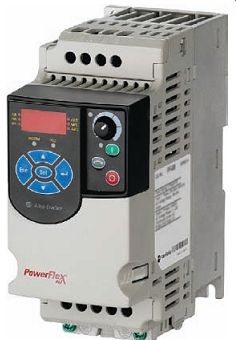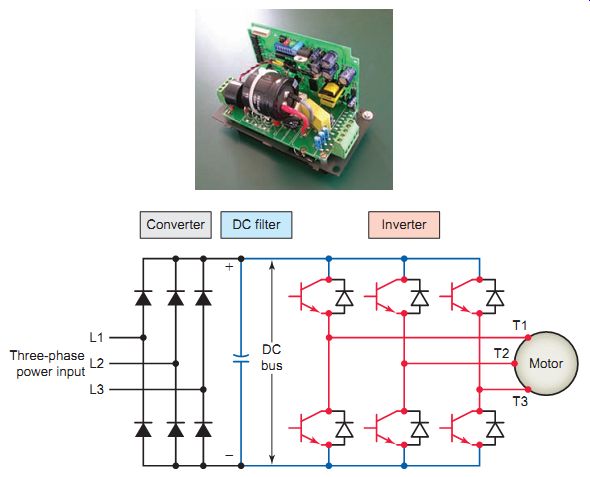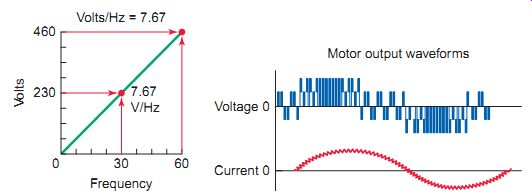AMAZON multi-meters discounts AMAZON oscilloscope discounts
Cont. from part 4
Alternating Current Motor Drives
AC drives connect to standard AC induction motors, and have capabilities of adjustable speed, torque, and horsepower control similar to those of DC drives. Adjustable-speed drives have made AC squirrel-cage induction motors as controllable and efficient as their DC counterparts. AC induction motor speed depends on the number of motor poles and the frequency of the applied power. The number of poles on the stator of the motor could be increased or decreased, but this has limited usefulness. Although the AC frequency of the power source in the United States is fixed at 60 Hz, advances in power electronics make it practical to vary the frequency and resulting speed of an induction motor.

Ill. 54 AC motor drive. Rockwell Automation, rockwellautomation.com.

Ill. 55 Variable-frequency drive controller. Computer Controls Corporation,
www.versadrives.com. Three-phase power input; Converter DC filter Inverter;

Ill. 56 The ratio of volts per hertz is regulated to a constant value.
Motor output waveforms;
Variable-Frequency Drive
A variable-frequency drive (VFD) system, also known as a variable-speed drive system, generally consists of an AC motor, a controller, and an operator interface.
Three-phase motors are usually preferred, but some types of single-phase motors can be used. Motors that are designed for fixed-speed main voltage operation are often used, but certain enhancements to the standard motor designs offer higher reliability and better VFD performance. A simplified diagram of a VFD controller is shown in Ill. 55. The three major sections of the controller are as follows:
Converter- -Rectifies the incoming three-phase AC power and converts it to DC.
DC filter (also known as the DC link or DC bus)--Provides a smooth, rectified DC voltage.
Inverter--Switches the DC on and off so rapidly that the motor receives a pulsating voltage that is similar to AC. The switching rate is controlled to vary the frequency of the simulated AC that is applied to the motor.
AC motor characteristics require the applied voltage to be proportionally adjusted by the drive whenever the frequency is changed. E.g., if a motor is designed to operate at 460 Volts at 60 Hz, the applied voltage must be reduced to 230 Volts when the frequency is reduced to 30 Hz. Thus the ratio of volts per hertz must be regulated to a constant value (460/60 = 7.67 in this case). The most common method used for adjusting the motor voltage is called pulse width modulation (PWM). With PWM voltage control, the inverter switches are used to divide the simulated sine-wave output waveform into a series of narrow voltage pulses and modulate the width of the pulses.
With a standard AC across-the-line motor starter, line voltage and frequency are applied to the motor and the speed is solely dependent on the number of motor stator poles. In comparison, an AC motor drive delivers a varying voltage and frequency to the motor, which determines its speed. The higher the frequency sup plied to the motor, the faster it will run. Power applied to the motor through the drive can lower the speed of a motor below the nameplate base speed, or increase the speed to synchronous speed and higher. Motor manufacturers list the maximum speed at which their motors can safely be operated.

Ill. 57 AC motor starter and drive control. Fixed line voltage and frequency;
Fixed line voltage and frequency; Line voltage and frequency; Varying
voltage and frequency; Base speed; Speed setting; Motor; RPM; Two poles-3,600
rpm Four poles-1,800 rpm

Ill. 58 Inverter-duty AC induction motor. Baldor Electric Company. baldor.com.
Inverter Duty Motor
Inverter duty and vector duty describe a class of AC induction motors that are specifically designed for use with variable-frequency drives . The high switching frequencies and fast voltage rise times of AC motor drives can produce high voltage peaks in the windings of standard AC motors that exceed their insulation break down voltage. Also, operating motors for an extended time at low motor rpm reduces the flow of cooling air, which results in an increase in temperature. NEMA-rated inverter- or vector-duty motors use high-temperature insulating materials that can withstand higher voltage spikes and operating temperatures. This reduces the stress on the insulation system.
AC motors frequently drive variable loads such as pumps, hydraulic systems, and fans. In these applications, motor efficiency is often poor due to operation at low loads and can be improved by using a VFD in place of speed controllers such as belts and pulleys, throttle valves, fan dampers, and magnetic clutches. E.g., a pump or fan, controlled by a variable speed drive, running at half-speed consumes only one-eighth of the energy com pared to one running at full speed, resulting in consider able energy savings.
QUIZ:
1. List the three basic sections of an AC variable frequency drive controller and state the function of each section.
2. An induction motor rated for 230 Volts at 60 Hz is to be operated by a VFD. When the frequency is reduced to 20 Hz, to what value must the voltage be reduced in order maintain the ratio of volts per hertz?
3. How does an AC drive vary the speed of an induction motor?
4. Inverter or vector duty AC induction motors are the types most often specified for use with variable frequency drives. Why?